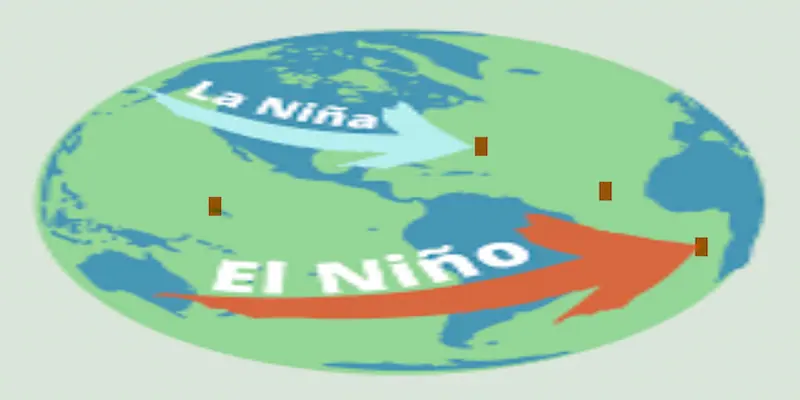Global weather: Strong climatic events like El Niño and La Niña have a big influence on worldwide weather patterns, affecting temperature extremes, rainfall, droughts, and storms. In order to plan for weather-related difficulties in agriculture, water management, and disaster preparedness, governments, farmers, and communities must have a thorough understanding of these cycles.
Here is a concise explanation of El Niño and La Niña, their mechanisms, and the significance of their effects on the global community.

El Niño and La Niña: What Are They?
The El Niño-Southern Oscillation (ENSO), a recurrent climatic pattern in the Pacific Ocean, includes both El Niño and La Niña phases.
El Niño:
El Niño is a phenomenon that affects weather patterns globally and happens when sea surface temperatures in the central and eastern Pacific Ocean become abnormally warm.
La Niña:
This is the opposite phase, characterized by sea surface temperatures that are lower than normal in the same areas, which has a variety of effects on weather across the world.
These variations in ocean temperature affect rainfall and temperature distributions, change jet streams, and modify atmospheric circulation patterns.
El Niño's Effect on the World's Weather
El Niño occurrences can last anywhere from nine to twelve months and usually happen every two to seven years.
Important effects include:
- Southeast Asian, Indonesian, and Australian droughts;
- Weather-related floods in the southern United States, Peru, and Ecuador.
- Increased wind shear suppresses Atlantic storms.
- Higher average global temperatures, which frequently result in record hot years.
- The South Asian monsoons were disturbed, impacting water and agricultural supplies.
El Niño may affect food production and increase the risk of disasters by causing severe droughts in places that depend on regular rainfall and excessive rainfall and flooding in other areas.
The Effects of La Niña on the Weather Worldwide
Additionally, La Niña can linger for nine to twelve months, and even for years. Its effects frequently resemble those of El Niño, but in the opposite way:
- 100% Higher rainfall in Southeast Asia, Indonesia, and Australia, which can occasionally result in floods.
- Dryer weather in Peru and the southern United States.
- Because of less wind shear, there are more active Atlantic hurricane seasons.
- Global temperatures have cooled, despite ongoing rising tendencies.
- % In South Asia, monsoon rains have intensified, occasionally resulting in floods.
While La Niña frequently alleviates drought in areas affected by past El Niño cycles, it may also cause landslides, floods, and agricultural damage from too much rain.
What Makes These Cycles Important?
Global economy, disaster preparation, water resources, and agriculture are all greatly impacted by El Niño and La Niña cycles. Food shortages and price increases may result from crop failures brought on by floods or droughts. Changing rainfall patterns pose a danger to the reliability of water supplies, and depending on the phase, disaster agencies need to be ready for higher risks of drought or flooding.
Keeping an eye on ENSO trends is essential in 2025 to predict catastrophic weather occurrences. Months in advance, scientists forecast ENSO phases using data on ocean temperature and atmospheric pressure, allowing areas to get ready for any potential effects.
Global Weather, ENSO and Climate Change
Although El Niño and La Niña are natural cycles, their frequency and severity may be affected by climate change. Greater El Niño occurrences might be fueled by warmer ocean temperatures, which could result in more severe heatwaves, droughts, and floods throughout the world.
Since forecasting the behavior of these cycles in a warming world is essential to developing worldwide adaptation strategies, climate scientists continue to work on understanding the link between ENSO and climate change.
What Are the Roles of Communities?
Planners for disasters, farmers, and governments can:
- Pay attention to ENSO predictions from organizations such as the World Meteorological Organization and NOAA.
- Modify agricultural plans, such as crop selection and irrigation techniques.
- Get disaster response systems ready for droughts or floods.
- Enhance water management to deal with supply fluctuations.
- Invest in robust infrastructure to endure severe weather conditions.
Concluding remarks
Global weather is greatly influenced by El Niño and La Niña cycles, which have an impact on everything from food production to hurricane seasons. Understanding and becoming ready for these natural cycles will be crucial to lowering risks and fostering resilience in a future where weather extremes are becoming more frequent as climate change continues to impact our globe.







 Bitcoin
Bitcoin  Ethereum
Ethereum  XRP
XRP  Tether
Tether  Solana
Solana  TRON
TRON  Dogecoin
Dogecoin  Litecoin
Litecoin